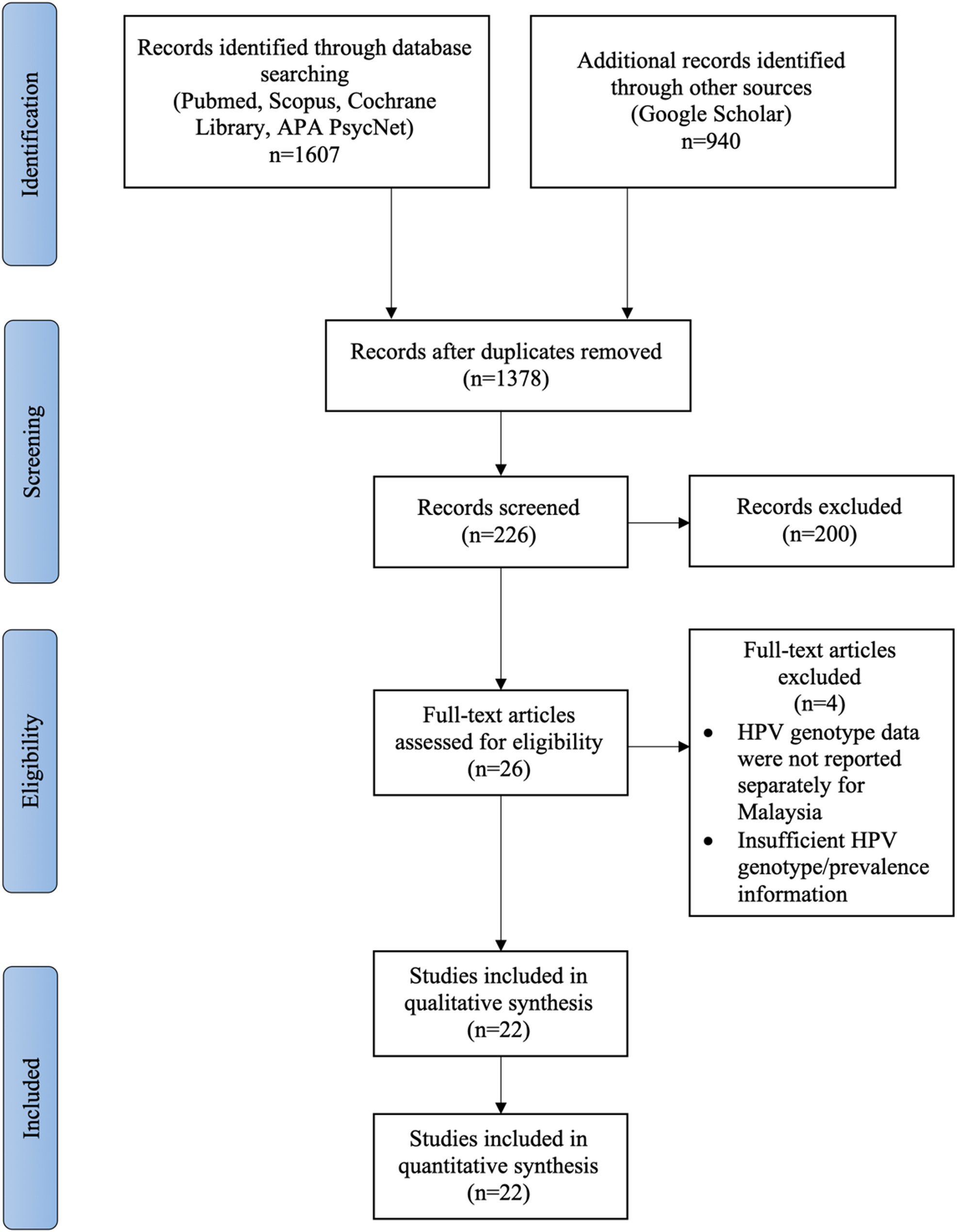Malaysia has a multi-ethnic population, and HPV prevalence varies across different races and regions. The country faces a crucial challenge in reducing HPV infections due to limited data. This systematic review provides a comprehensive overview of HPV genotype prevalence in cervicovaginal samples across Malaysia, based on 22 studies from both Peninsular and East Malaysia. The findings highlight a consistently high prevalence of high-risk HPV (hrHPV) types, particularly HPV16 and HPV18, which are the two genotypes most commonly associated with cervical cancer globally. Other frequently detected hrHPV genotypes include HPV52, HPV58, HPV33, and HPV45, which were found across various population groups and regions. These trends are consistent with previous studies in Asia and globally [16,17,18].
HPV infection was more commonly found in women aged 30 years and above, accounting for 75.8% of reported cases [16, 19,20,21,22,23]. This trend likely reflects persistent infection acquired earlier in life, combined with the fact that these cohorts were not eligible for the Malaysia’s school-based HPV immunization program, which was introduced in 2010 and targets 13-year-old girls. The publication window beginning in 2000 therefore includes women largely unvaccinated at the time of data collection. Although awareness of HPV has historically been low, modest improvements have been observed in recent years [24]. Among the general population, HPV prevalence ranged from 4.4 to 46.7%, whereas in women with abnormal smears or cervical cancer, prevalence ranged from 27.2 to 100%.
In cytologically normal samples, HPV detection was notably high (47.6%), similar to trends seen in Thailand (72.9%) [25]. Among cytological abnormalities, HPV was most prevalent in LSIL (22.9%), followed by atypical squamous or glandular cells (8.6%), and HSIL (5.7%). In cervical cancer specimens, HPV infection was found in 67.4% of SCC cases, 19.8% in ADC, and 0.7% in atypical squamous cells (ASC). HPV16 emerged as the most frequently detected genotype across all lesion grades, followed by HPV18, 58, 52, and 33, though distribution varied by lesion severity, ethnicity, and region [17, 22, 26, 27].
Overall, high-risk HPV types accounted for 97.7% of cases, while low-risk types made up 2.3%. Notably, the genotype distribution varied across regions. In West Malaysia, HPV16 and HPV18 were the most prevalent types. In East Malaysia, HPV52 and HPV58 were predominant in Sarawak, while HPV56 and HPV70 were more frequently observed in Sabah. Interestingly, HPV70 was more common in East Malaysia compared to the West, aligning with broader regional trends noted by Peng et al. (2012) and supporting the idea of geographic variation in genotype distribution across East and Southeast Asia [18].
This review further emphasizes variation in HPV genotype distribution among different ethnic groups. Among Malaysians, HPV prevalence was highest among Malays (61.2%), followed by Chinese (22.0%) and Indians (12.0%). In East Malaysia, specific Indigenous populations, such as the Kadazan-Dusun, Iban, and Bidayuh, also showed evidence of HPV infection, though sample sizes were limited. The distribution of genotypes also varied: HPV58, HPV52, and HPV56 were more common among Malays; HPV33, 52, and 45/58 among Chinese; and HPV51, 45, and 58 among Indians. Although research on ethnic disparities in HPV prevalence is limited in Malaysia, these findings are consistent with international data showing variation across ethnic groups. For example, HPV positivity was highest among non-Hispanic Blacks and lowest among Mexican-born Hispanic Whites in the U.S [28].
Given that HPV is responsible for over 95% of cervical cancer cases globally, these findings reinforce the critical importance of early detection and prevention [29]. Vaccination remains the most effective primary prevention method. While the bivalent vaccine provides nearly complete protection against HPV16 and 18 [3, 30, 31], the broader protection offered by the 9-valent vaccine (covering HPV31, 33, 45, 52, and 58) is particularly relevant to the Malaysian context [32]. This review found that, in addition to HPV16 and 18, high-risk types such as HPV52, 58, and 33 were frequently detected, especially in East Malaysia and among certain ethnic groups. These genotypes are included in the nonvalent vaccine, suggesting that broader adoption of this vaccine could enhance protection in regions and population where non-16/18 types are more prevalent. For instance, HPV52 and 58 were predominant in Sarawak, while HPV33 was more frequently found among Chinese women. Aligning vaccine strategy with these distribution patterns could strengthen national prevention efforts and help reduce regional and ethnic disparities in cervical cancer outcomes. Nevertheless, gaps in vaccine coverage and public access persist, especially in rural areas and among underrepresented populations [3, 33].
These findings support the ongoing need for regionally tailored HPV prevention strategies in Malaysia. This includes expanding surveillance, enhancing access to the nonavalent HPV vaccine, and integrating education and outreach programs to address persistent disparities in screening and vaccination uptake.
Strength and limitation
This systematic review provides valuable insights for revising Malaysia’s current vaccination strategies and HPV-based screening programs. The inclusion of studies from diverse settings and populations provides a broader understanding of HPV genotype distribution across the country. However, certain limitations should be considered when interpreting the findings. First, the predominance of studies from West Malaysia restricts a comprehensive assessment of HPV genotype distribution nationwide. Second, variations in HPV genotyping methods and differences in study participant selection may contribute to inconsistencies in the reported data. Finally, the possibility of participant overlap across studies especially those using national or institutional databases. Due to limited reporting in the original studies, we could not fully verify the independence of all samples, which may introduce some duplication bias.
